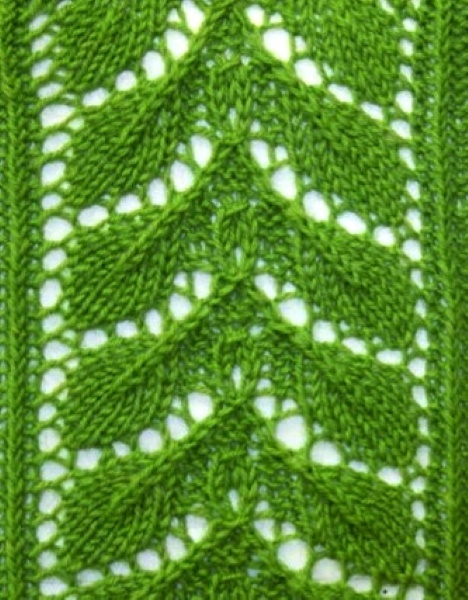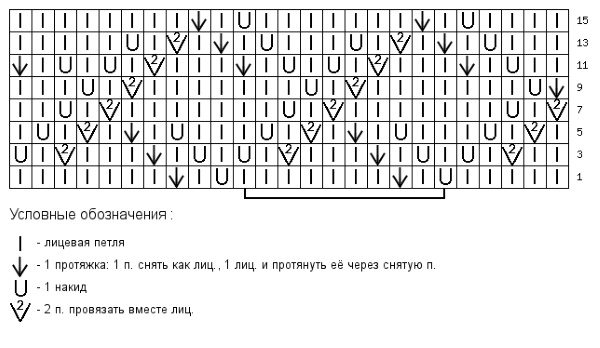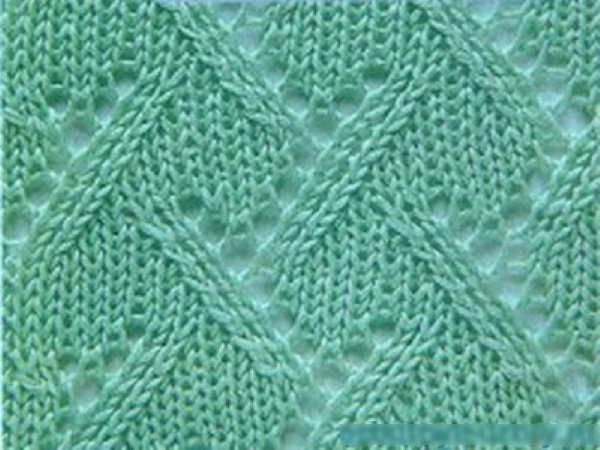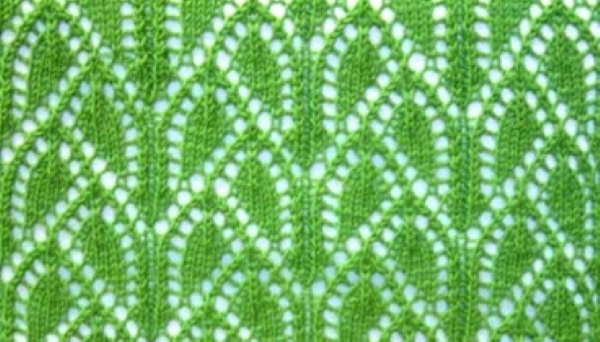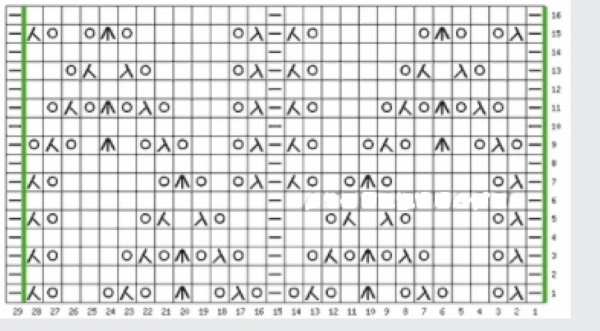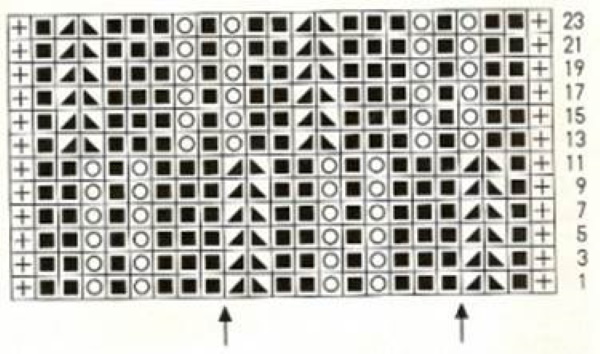Fashion does not stand still, but knitted summer cotton blouses always remain in trend. Their beauty, originality and uniqueness give a woman a special charm and are combined with many other wardrobe items. The choice of model, knitting needles, yarn, pattern, as well as important and useful tips will be discussed further in the article.
How to knit a summer blouse with knitting needles
Summer blouses knitted with cotton needles create comfortable conditions in hot weather and warm on a cool evening. This is ensured by the natural composition. As a rule, cotton threads used for knitting light items are thin with varying degrees of twist. This, in turn, has a great influence on the structure of finished items. Thus, yarn with a dense twist is more convenient in the process of work: it does not delaminate and clearly fits into the pattern.
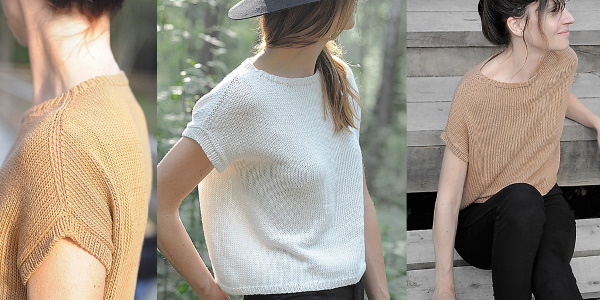
But its disadvantage is a fairly dense and coarse fabric. Threads with a weak twist, on the contrary, provide products with a soft and loose structure. But in the process of knitting they create some discomfort, delaminating into thin component threads. Incomplete capture of them by knitting needles distorts the pattern and gives the fabric an unsightly appearance. Therefore, before choosing yarn, it is advisable to decide on the purpose of the thing, as well as assess your capabilities in working with this or that type of twist.
Modern specialized handicraft stores offer a huge selection of threads, from the thinnest, designed for knitting with four needles, to thicker ones. The choice of yarn depends on the model of the blouse, the structure of the pattern, the place and time of use, the combination with other wardrobe items. And correctly selected needles and pattern will ensure complete satisfaction with the work done.
To figure out which knitting needles are best to use for the yarn you have purchased, you should decide what density of fabric is needed for the selected model. If the style provides for a soft, flowing texture of the product, it is recommended to use knitting needles 1.5 - 2.5 numbers larger than the thickness of the threads. This will reduce the knitting density and give additional openwork, softness and pliability to the fabric.
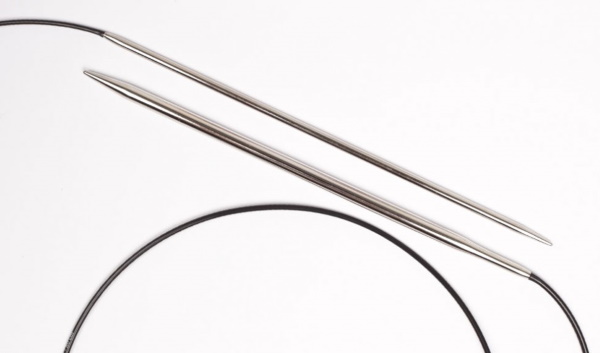
If the model should hold a certain shape and have a dense texture, the number of needles should be equal to the thickness of the yarn or be 1-1.5 values less. Therefore, experienced craftswomen recommend that before starting the main knitting, you should make several small samples using needles of different thicknesses. Then choose the most suitable option. This technique will ensure productive work without further alterations and corrections.
With a relief pattern
Summer blouses knitted with cotton needles using relief patterns create the effect of volume and plumpness. Thus, products with a large number of relief elements are more suitable for slim and thin women. But things in which relief fragments are not used often and are combined with other patterns will perfectly suit any female figure.
And those located in the vertical direction visually increase height, which additionally gives lush forms a slimmer look. The main component of the relief pattern is the "braid". It would seem that it is intended only for warm, massive sweaters, jumpers, vests and other winter items.
But made from thin yarn and thicker knitting needles, it will decorate any summer product, including a summer blouse. And in combination with an openwork path, it will give it additional elegance and charm. Below are several models for summer using relief fragments. Most models use a braid as the most common relief element. There are many variations of its execution.
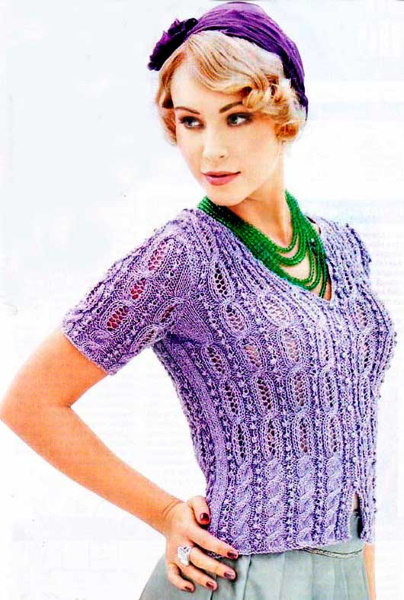
Here is a list of some of them:
- An even number of loops that are divided in half and crossed over each other after the required number of rows.
- An even number of knit stitches separated by one or more purl stitches to create more relief.
- Two strands of front loops, forming a braid, separate the inclusions of loops with yarns, giving the fabric an openwork and light look.
- Between the paths of narrow braids, openwork stripes are knitted, which also create a smart and delicate look for the product.
- The braids are connected to each other with rare horizontal constrictions in the area of the widened sections. This method can be somewhat difficult for knitters who do not know how to crochet, since this method of coupling is done in the process of tying the sides of each braid.

In the next model, relief braids are used in the yoke area and serve as a decorative design for the neck of the blouse. This style involves making the yoke separately from the main fabric. This use of relief braids adds charm, elegance and appeal to the product.
Openwork blouse with knitting needles
Summer blouses knitted with knitting needles from cotton are an excellent alternative to knitted tops and vests, used both as separate items and as a set with a trouser or skirt suit. Depending on the yarn used for production, their use time also varies.
Made from cotton or synthetic materials, the products will not cause discomfort in hot weather, and knitted from yarn with the addition of wool or cashmere will warm you on cool weekdays. The variety of types and models of openwork summer blouses is huge, but some of them are discussed below.
The first model is a summer openwork sleeveless blouse. Its elongated style allows the model to be used in various variations, be it a belt or a free falling position. This makes it possible to emphasize the advantages or hide the disadvantages of a woman's figure.
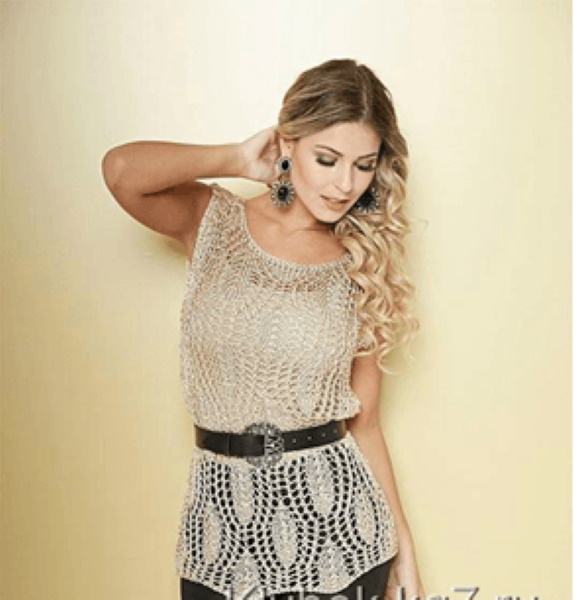
And the longitudinal direction of the pattern provides a visual increase in height and gives a slimmer waist. This model can be used as a separate wardrobe item, as well as in combination with trousers or a skirt.
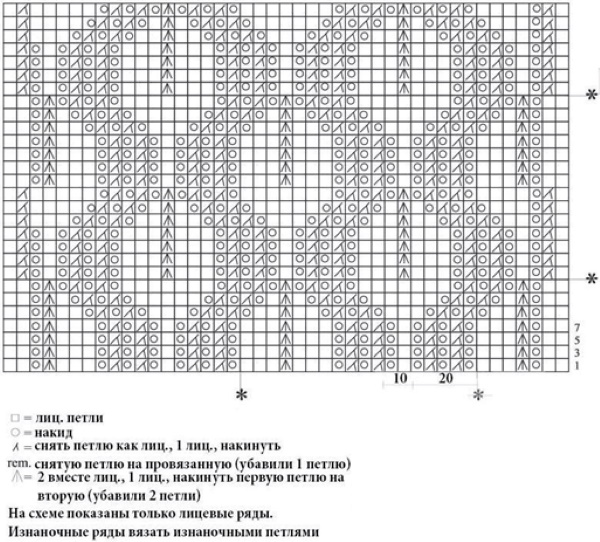
To make this blouse, you can use different types of yarn:
- cotton;
- viscose;
- with the addition of silk;
- acetate;
- acrylic;
- with a small content of wool or cashmere.
It is not advisable to knit from pure wool or cashmere threads, since the knitting density of the pattern is loose, and the twist in such yarn is weak. Therefore, with further wet-heat treatment or wearing, deformations of products or their shrinkage are possible. The presence of synthetic inclusions is a deterrent to the above phenomena.
Depending on the desired result, it is recommended to use knitting needles 1-2 sizes thicker than the thread to perform the work. In this case, the fabric is openwork, light, airy, with a clear pattern. If you use knitting needles of a thickness similar to the thickness of the yarn, the knitting density increases, the pattern decreases, the fabric becomes more rigid. Therefore, the choice of a suitable tool depends only on the desire of the performer.
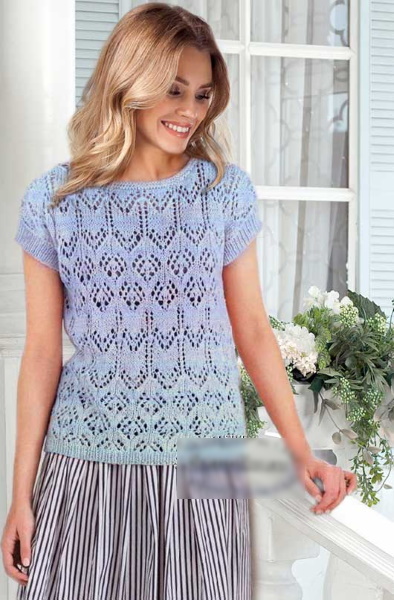
The following model only at first glance seems complicated and difficult to implement. But this is not so at all. The pattern scheme is quite simple and is a combination of two types of ornament, in which a small number of symbols are used.
The pattern also does not have complex elements and can be made even by beginners. It consists of two parts: front and back. The armhole is not performed in this case, and the straight upper part of the parts makes up a dropped sleeve. All that remains is to correctly and symmetrically close the loops of the neck on both sides. To do this, it is enough to carefully follow the shown diagram, which clearly indicates the number and sequence of closing loops in each row.

In order to accurately calculate the required number of loops for a certain size, experienced craftsmen recommend making a trial sample of the pattern with the selected number of needles before starting the main knitting. This will not only avoid further mistakes and miscalculations, but also create a product that meets the required measurements.
After completing the sample, measure the number of loops per 1 cm of fabric. Then multiply this value by the hip measurement. This will give you the total number of loops needed for the selected size. Then divide the resulting value in half to get the number of loops for the front and back halves of the blouse. After these manipulations, you can confidently proceed to further work.
For beginner knitters, the initial rows after the elastic band can cause difficulty. Here, special attention should be paid to the pattern and the work being done, because the subsequent ornament depends on the correct knitting of the beginning of the pattern. But this discomfort goes away after performing several straight and reverse rows, since the pattern itself and the direction of the loops will suggest further actions.
After finishing knitting both parts, they are assembled by sewing with a needle and thread or a crochet hook. Then the edges of the sleeves are decorated with an elastic band similar to the bottom, and the neck is crocheted. The resulting finished product is subjected to wet-heat treatment.
Below are samples of patterns and diagrams for them, which can be used for knitting openwork summer blouses. To get the most suitable option for the density of the fabric, do not be lazy, but try to knit a sample with several numbers of knitting needles and choose the best one.
Each of them can be both the main fabric and perform a decorative function in the form of partial use of one or several individual rapports. They can be used to emphasize attention when introduced into the main fabric, made with satin stitch, or to emphasize the elegance of the product, combining with other patterns.
Patchwork Fantasies
Summer blouses, knitted with knitting needles from cotton in the patchwork style, are currently at the peak of fashion. They carry a variety of use of different, sometimes completely incompatible patterns, in one product. Threads of different structure and color, from which patches of geometric shape, different in size, skillfully laid out by the master in a holistic composition, are knitted, amaze with their beauty and uniqueness.
One of the simplest options is presented by the first model. Rectangles knitted from single-color yarn with two different patterns are sewn into a single piece. The combination of horizontal and vertical patterns gives the finished product originality and femininity.
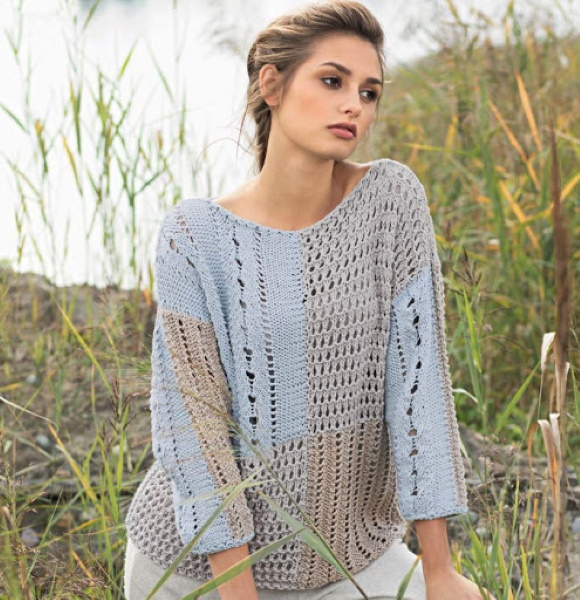
The next model is more suitable for cool summer evenings. A masterfully selected combination of calm colors with various patterns creates a truly charming composition.
A simple, unpretentious pattern, without smooth curved lines, gives beginners the opportunity to experiment in creating their own vision of the design in the finished product.
There are several options for connecting the elements of the canvas:
- by stitching with thread and needle;
- using a hook;
- with lace or trim insert;
- in the process of knitting.
The most difficult of the listed methods is coupling during the work process. To do this, the knitter must already know the location and sizes of the fragments used in the work. Performing two elements horizontally at the same time from different yarn and patterns, they are connected in each row by wrapping one thread around the next.

When moving from one vertical fragment to another, the loops are not closed, but the next color is introduced into the work and knitting continues. Thus, a whole fabric of different structure is obtained without the need for subsequent joining of parts. The final wet-heat treatment of the finished product will help to give the areas of connection uniformity and smoothness.
Variations of square motifs
Summer blouses in simple versions, knitted with knitting needles from cotton, are a composition of squares. They are easy to make, but the use of different color solutions and yarn makes it possible to create a variety of models. The originality of the squares is given by the process of their knitting, which consists of uniformly decreasing loops in the center of the figure.
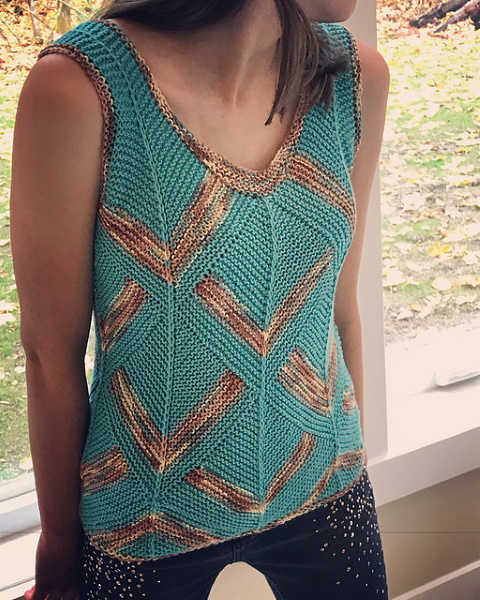
The use of contrasting colors or threads with different structures ensures the exclusivity of the product, as well as the use of yarn remnants when creating the overall composition of the pattern. The simplicity of this type of knitting summer blouses, T-shirts, tops is that they are knitted only with face loops, which is the basis for beginner needlewomen.
Before starting any work, experienced craftswomen strongly recommend paying special attention to the correct calculation of the required size.
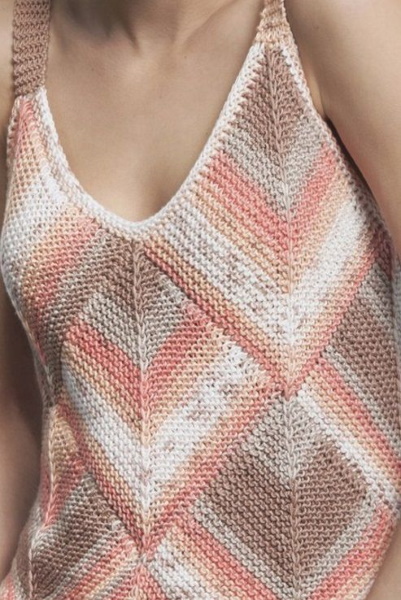
To do this, it is necessary to knit a small sample of yarn that will later be used for the product. This way, you can accurately determine the knitting density and calculate the optimal parameters of the elements (if the product involves their use).
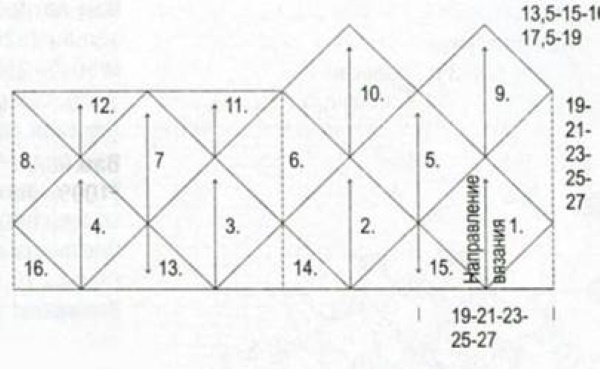
The next stage of work is determining the location of geometric fragments according to the completed pattern. An example of the placement of squares is shown in the diagram below. Having corrected possible discrepancies by increasing or decreasing the size of the elements, you can begin knitting the product. In this case, the occurrence of errors and shortcomings in the work, which are often quite difficult to correct, is practically excluded.
With a round yoke
Summer blouses with one-piece round yokes are especially popular among modern women. Made in the form of openwork collars, they add charm to the female silhouette and emphasize the beauty of the face and neck. Products in this category are knitted with circular knitting needles, which ensures the evenness of the fabric and facilitates convenient calculation of loops for further work.
The "highlight" of this technique is the complete absence of seams, which guarantees that the product will not be distorted in any area. The knitting process is carried out from top to bottom. This creates additional convenience for trying on the blouse, timely correction and adjustment to the figure if necessary.
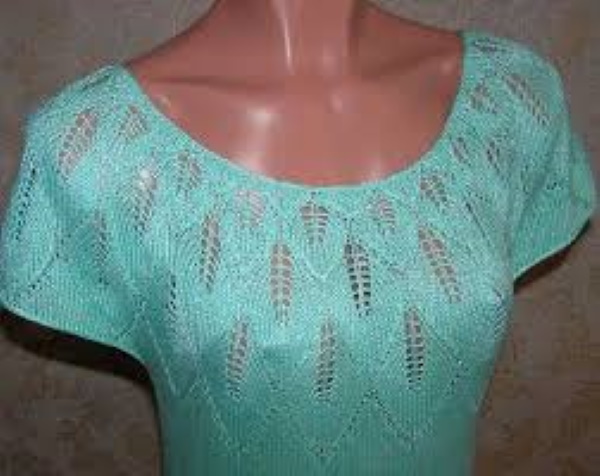
Openwork yokes can have a continuation in the same pattern to the bottom of the fabric, and also go great with both regular satin stitch and other patterns that are outwardly similar to the elements of the ornament at the beginning of the product. If the style provides for a close-fitting silhouette, then this operation is carried out by decreasing and adding loops in the waist area.
If the product consists entirely of a pattern, then when decreasing and adding loops, it is necessary to strictly ensure that they fit organically and symmetrically into the overall pattern. Otherwise, the pattern will be distorted and it will be impossible to correct it in the finished product.
If you have a large neckline when casting on the first row of stitches, don't worry. This can be easily fixed by crocheting it and then reducing the stitches in each row. Also, if you don't have a crochet hook, you can pull a decorative cord or braid (plain or contrasting) along the edge of the garment at regular intervals and tighten it to the desired size. You can also use a similar trim instead of a belt.
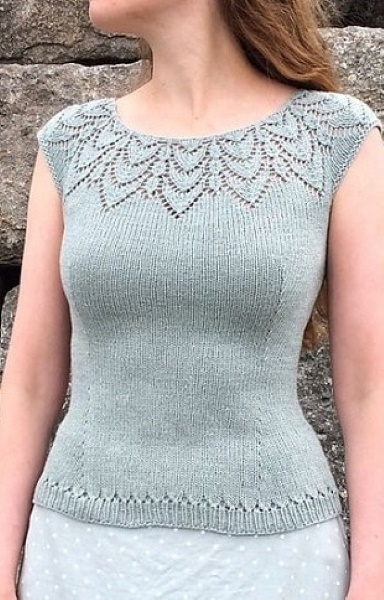
When creating your wardrobe, you should not spend significant amounts of money on purchasing exclusive items. It is enough to make yourself a gift in the form of summer blouses knitted with knitting needles from cotton. This will not only bring a gorgeous result, but also bring great pleasure in the process of work. And the advice and recommendations of experienced craftswomen given in this article will help to avoid possible disappointments and mistakes.
Video about knitted summer blouses
Summer top, knitted:

